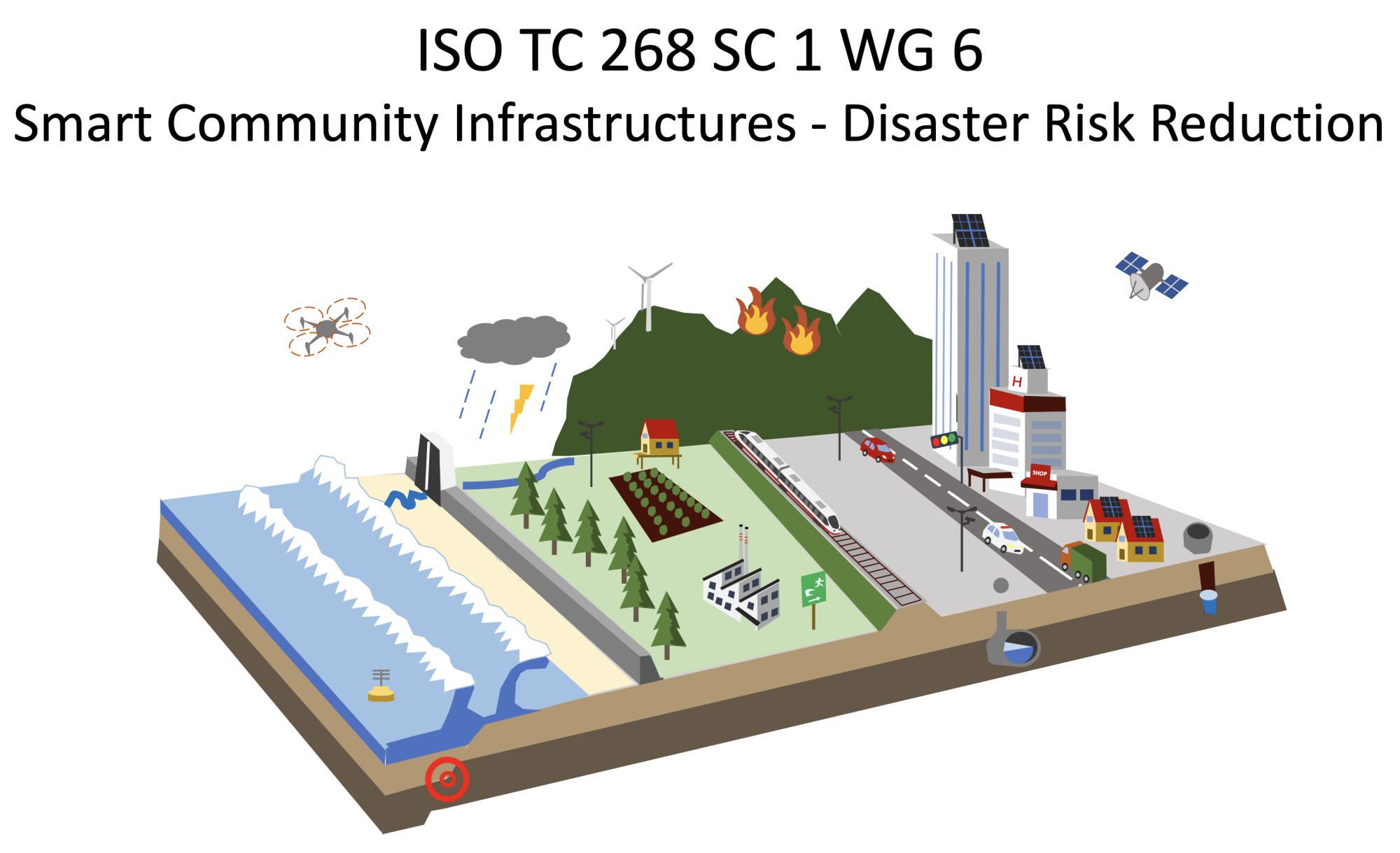Smart Community Infrastructures: Disaster Risk Reduction (ISO/TC268/SC1/WG6)
We are a working group under the International Organization for Standardization’s ISO TC 268 SC1 Smart Community Infrastructure. Our working group focuses on the standardization of smart community infrastructure which could strengthen community resiliency against potential disasters.
Description
In the past decades, communities have made great progress towards strengthening their resiliency towards natural hazards and reducing disaster risks globally. However, climate change is expected to exacerbate the frequency and intensity of these hazards, which could potentially expose more communities to increasing vulnerabilities. Critical community infrastructures, such as transportation, energy, telecommunications, medical services, schools, banks, and homes may become under increasing risk in the future. The costs of recovering from disasters have also skyrocketed, as communities struggle to recover and rebuild from its impacts.
Simultaneously, the global demand for smart community infrastructures continue to rise as communities become increasingly sensitive to environmental changes, improvement in technologies, and how such technologies can be utilized to better integrate people to the natural and built environments which could improve quality of life. The demand for smart infrastructure in conjunction with climate change and increasing vulnerabilities to disasters, creates an opportunity for us to examine the potential in standardizing smart community infrastructure that is designed to strengthen community resiliency to disasters.
The resiliency of key community infrastructures such as food security, energy, water systems, the environment, medical services, schools, among others serve as the core of our goals. Due to our overlapping interests and targets in disaster resiliency and sustainability, our working group bases our approach to potential deliverables, such as technical reports and international standards, on the Sendai Framework 7 Global Targets and all 17 of the United Nation’s Sustainable Development Goals.
As a working group under the International Organization for Standardization (ISO), we seek to collaborate with stakeholders from multiple countries and communities to seek a shared understanding of current and future global vulnerabilities, and to develop a holistic approach to the development of standards for smart community infrastructures that can meet both the Sendai Framework global targets and sustainable development goals. For more about ISO visit https://www.iso.org/about-us.html
Did the Sendai Framework change or contribute to changes in your activities/organization? If so, how?
The Sendai Framework for Disaster Risk Reduction encourages to makes greater emphasis on managing risks (prevention) as compared to managing disasters (reaction). Making use of this framework and supporting its implementation, our working group is committed to advance the standardization of smart community infrastructure because it encourages and provides specific tools to materialize a prevention attitude towards risk, among other benefits. Furthermore, the Sendai framework underlines the importance of enhancing “the scientific and technical work on disaster risk reduction and its mobilization through the coordination of existing networks and scientific research institutions at all levels and in all regions.”
What led you to make this commitment/initiative?
What was your position before making this Voluntary Commitment / prior to the Sendai Framework?
We believe that the standardization of community infrastructure presented as specific deliverables such as technical reports and international standards could strengthen community resiliency against potential disasters. The Sendai Framework makes clear that “there is a need for the public and private sectors and civil society organizations, as well as academia and scientific and research institutions, to work more closely together and to create opportunities for collaboration, and for businesses to integrate disaster risk into their management practices.” In addition, we are motivated by the concrete call to develop “standards, codes, operational guides and other guidance instruments, to support coordinated action in disaster preparedness and response.” The deliverables produced are intended to foster the exchange of ideas and technologies between developed and developing country in hopes of strengthening disaster resiliency.
Deliverables and Progress report
Deliverables
Deliverables are the end-products of the initiative/commitment, which can include issuance of publications or knowledge products, outcomes of workshops, training programs, videos, links, photographs, etc.
This report is a review of existing and upcoming smart community infrastructure related to strengthening resiliency to disasters. This report identifies potential areas of global collaboration as well as gaps that need further research in.
This document provides guidelines for the development, implementation and maintenance of seismometer
systems as a part of the infrastructures for disaster risk reduction in smart communities. The seismometer
systems in this document can be used for the observation of seismic activity such as earthquakes, microseismic
and volcanic tremors.
This document shows examples on how different types of seismometers can be utilized to meet the needs and
expectations of users and help planners, developers, and operators of communities to utilize seismometers
and their data for disaster risk reduction in an effective manner.
This International Standard was published in February 2024 and is available at the ISO website.
The technical report will be used to serve as a basis for multiple international standards, which provide more detail on specific infrastructures that could be standardized.
This document provides guidance on how to select seismometer systems as a part of smart community infrastructures for disaster risk reduction. It enables planners, developers, and community operators to determine if intended purposes are achieved by seismometer systems through examples of selection and use of seismometer systems based on the categories defined in ISO/DIS 37174
Porgress report
Since the last update, our working group within ISO TC 268 SC1, has published another deliverable, its first International Standard, ISO 37174, which was published in February of 2024.
Following this, two other international standards are under development, ISO 37179, and ISO 37194.
our working group has published two deliverables that contribute to DRR,
ISO TR 6030
and
ISO 37174
Organizations and focal points
Implementing Organization(s)
Focal points
Partners
